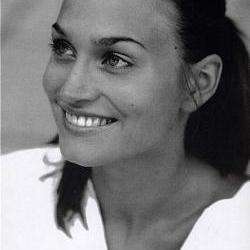Carl Maria von Weber’s rarely staged final opera has all the makings of a romantic testament to true love. Fairies, star-crossed lovers and shipwrecks; it is A Midsummer Night’s Dream crossed with epic French poetry and an excursion to Baghdad thrown in. Director Nikolaus Habjan took Oberon’s inherent miscellany and ran with it, straight into a retro-futurism aesthetic. The fairy king, Oberon (Mauro Peter) and queen, Titania (Juliette Mars) are squabbling scientists in a chrome lab with blinking panals (sets: Jakob Brossman, lighting: Michael Bauer). Their “fairies”, identically clad scientists (Arnold Schoenberg Chor) with clean-cut Japanese wigs (costumes: Denise Heschl), carry out experiments on patients using psychedelics, electro-shock therapy, Rorschach tests and cardboard sets. There is a lot of humour, occasionally even bordering on camp, but always paired with the grotesque.
Puppets, Habjan’s calling card, are very much in play. Oberon manipulates a towering white shirt, papier-mâché head and green hands glowing, as he sets the stage for his subjects. His bidding is carried out by not one, but three puppeteering Pucks (brilliant: Manuela Linshalm, Daniel-Frantisek Kamen, Sebastian Mock), interacting with the subjects using a variety of different figures, from pirates to Doppelgängers to caliphs to mermaids. And who are their subjects? Patients convinced through drugs and suggestion that they are Sir Huon of Bordeaux (Vincent Wolfsteiner), in love with the caliph’s daughter Rezia (Annette Dasch), and their attendants Fatima (Natalia Kawalek) and Sherasmin (Daniel Schmutzhard). Though one of the pairs does manage to weather the (electroshock) storms and remain tethered together at the end, they are shaky, vacant messes, destroyed by the very experiment which flung them together.
Musically, Oberon is similarly patchwork in nature. Spoken text is interwoven with sweeping instrumental interludes – the opening overture alone lasts nearly 10 minutes – as well as arias, duets and ensemble numbers which run from the epically dramatic to the quietly negligible. Extensive rewriting of the spoken libretto was clearly undertaken and has historic precedents – as is considerable flexibility with the music. Puck’s vocal work, for example, is sung here by Juliette Mars, which works very effectively. Mauro Peter and Daniel Schmutzhard have comparatively little to do vocally but do that very well, and Natalia Kawalek is an energetic force of nature on the stage; her passage work in duet flawless. Annette Dasch is the most memorable of the vocal cast. Her “Ozean, du Ungeheuer” is one of the rare moments where the music is not partially eclipsed by the involved design and staging. Only tenor Vincent Wolfsteiner was truly spotty. In extrovert, martial passages he absolutely gleamed, but his softer, lyric work occasionally seemed slightly tortured.
Rising star Thomas Guggeis led the Vienna Chamber Orchestra impressively, particularly given his youth, but occasionally lacked the direction and sweep necessarily to propel singers through Weber’s vocal lines. Weber famously influenced Wagner, but was also a child of virtuosity. His work is richly textured and demands vocal heft, but also flexible coloratura, a combination which can be deadly. Singers need every wind blowing in their favour to navigate his melodies flawlessly. That being said, the orchestra, after a tentative start, played courageously and with an expressive force belying their chamber constellation.
By all accounts, this is one of Theater an der Wien’s most congruent and expansive productions of late. The engagement and energy of all contributors is a breath of fresh air, and the work and thought put in is apparent in every detail, a tribute to the leading team as well as cast and crew.




